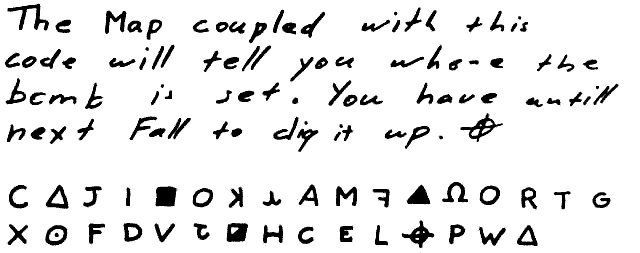

- #HANDWRITTEN APPLE SERIAL NUMBER MYSTERY BY DRIVER#
- #HANDWRITTEN APPLE SERIAL NUMBER MYSTERY BY CODE#
- #HANDWRITTEN APPLE SERIAL NUMBER MYSTERY BY FREE#
Wondering if there was something wrong with the way I modified the pointer, I tried placing the colour in an unused part of memory that was already created by the Metal driver – that worked. Despite encoding the same bits as before, the GPU would fail to clear correctly. However, by working one bit at a time, errors could be pinpointed and fixed immediately, providing a faster turn around time and a more pleasant bring-up experience.īut curveballs there were! My momentary elation at modifying the clear colours disappeared when I attempted to allocate a buffer for the colours. If there is a single typo in five hundred lines of magic numbers, there would be no feedback, except an error from the GPU. I had used that alternate technique to bring-up Mali a few years back, but it comes with the substantial drawback of fiendishly difficult debugging. Iterating in this fashion, I could build up every structure needed while testing each in isolation.ĭespite curveballs, this procedure worked out far better than the alternative of jumping straight to constructing buffers, perhaps via a “replay”. After that, I could try uploading the commands for the shader myself.
#HANDWRITTEN APPLE SERIAL NUMBER MYSTERY BY CODE#
But it’s not necessary to stop at these “leaf nodes” of the system after modifying the shader code, I tried uploading shader code to a different part of the executable buffer while modifying the command buffer’s pointer to the code to compensate. Similarly, while learning about the instruction set to bring up the disassembler, I replaced shaders with handwritten equivalents and confirmed I could execute code on the GPU, provided I wrote out the machine code. As an early “hello world”, I identified the encoding of the render target’s clear colour in memory, and demonstrated that I could modify the colour as I pleased. Since my IOKit wrapper exists in the same address space as the Metal application, the wrapper may modify command buffers just before submission to the GPU. As there is a bit of “magic” around memory and command buffer allocation on macOS, having this code working at an early stage gives peace of mind going forward. Since GPU virtual addresses change from run to run, the demo validates that all of the pointers required are identified and can be relocated freely in memory using our own (trivial) allocator. In other words, the demo code is not yet intended to demonstrate an understanding of the fine-grained details of the command buffers, but rather to demonstrate there is “nothing missing”. That description of the vertex shader, including the address of the code in executable memory, is pointed to by another buffer, itself referenced from the main command buffer, which is referenced by a handle in the IOKit call to submit a command buffer. That internal table is passed directly as input to the vertex shader, specified in another buffer. An internal table in yet another buffer points each of these vertex buffers. The bring-up process for the project’s triangle provides a bird’s eye view of how all these disparate pieces in memory fit together.Īs an example, the application-provided vertex data are in their own buffers.

In particular, the structures contain pointers to one another, sometimes nested multiple layers deep. So far, I have focused less on the content and more on the connections between them. Any state accessible from Metal corresponds to bits in these buffers, so understanding them will be the next major task. The bulk of the new code is responsible for constructing the various command buffers and descriptors resident in shared memory, used to control the GPU’s behaviour. A triangle rendered on the M1 with open-source code The vertex and fragment shaders are handwritten in machine code, and I interface with the hardware via the IOKit kernel driver in an identical fashion to the system’s Metal userspace driver. This week, I’ve reached a second milestone: drawing a triangle with my own open-source code.
#HANDWRITTEN APPLE SERIAL NUMBER MYSTERY BY FREE#
Less than a month ago, I began investigating the Apple M1 GPU in hopes of developing a free and open-source driver. Rosenzweig – Dissecting the Apple M1 GPU, part II Dissecting the Apple M1 GPU, part II


 0 kommentar(er)
0 kommentar(er)
